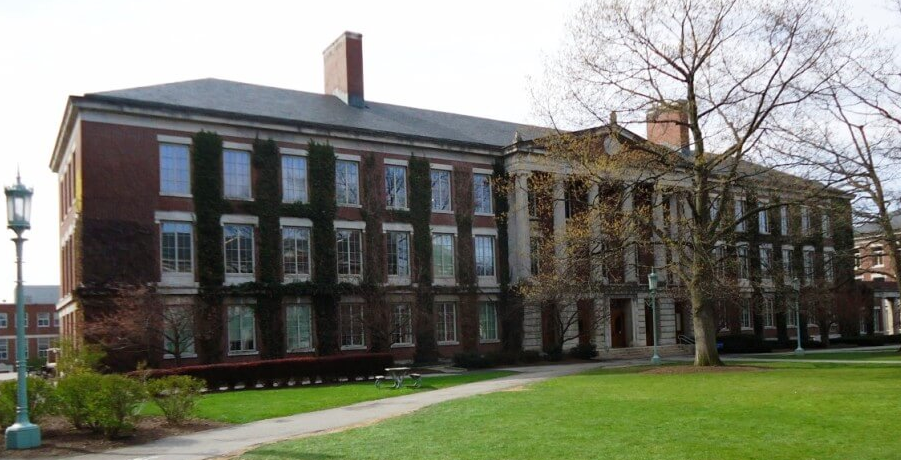
| River Campus | Bausch & Lomb Hall |
 |
| Bausch & Lomb Hall |
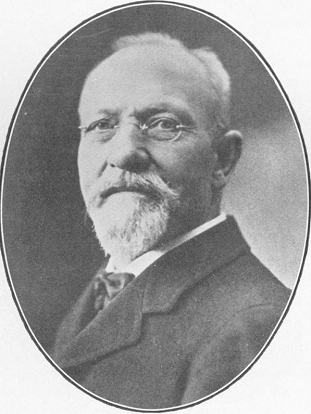 |
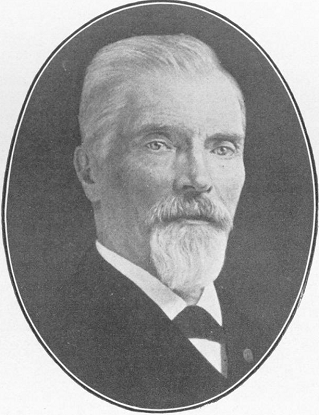 |
| John J. Bausch |
Henry Lomb |
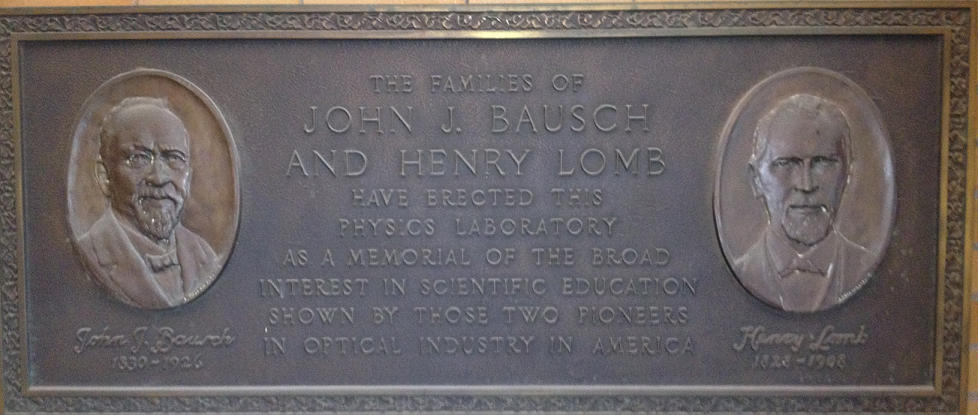 |
| Plaque in Bausch & Lomb Hall |
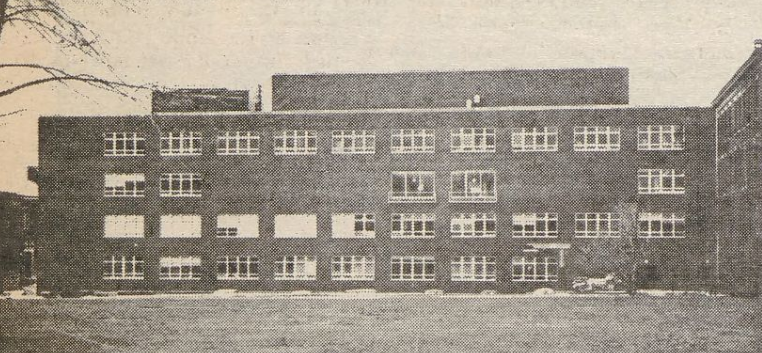 |
| Bausch & Lomb Annex |
Bausch & Lomb Hall opened in October 1930 on the south side of Eastman Quadrangle as the John J. Bausch Henry Lomb Memorial physics building. It was named for John Jacob Bausch and Henry Lomb, founders of the Bausch and Lomb Optical Company and funded by a $300,000 gift made by the company and members of their families.
The balcony on the back of the building was requested by Professor Brian O’Brien to allow him to "study the sun’s rays from sun rise to sun set” using a spectroscope weighing 800 pounds that was connected to equipment within the building. It was completed in November 1930 at a total cost of $891.
The Institute of Optics occupied the fourth floor of the building until moving to the Space Science building (now Wilmot Hall) in the winter of 1977-1978.
A 7-million-Volt cyclotron was installed in the building in 1936 and was joined by a 250-million-Volt cyclotron installed in a separate building that began operating in 1949. The smaller cyclotron was shut down on October 11, 1965, and shipped one year later to India as a teaching tool at Kurukshetra University. Within a few years it was relocated to Chandigarh, where it continues to operate.
A five-story wing was added to the south side of the building in 1962. The penthouse of this wing contained a Carrier single-effect steam absorption chiller and cooling tower that provided chilled water to air condition the new wing and also the nearby Hoyt Auditorium. A similar chiller had been installed earlier in the Administration Building. Chilled water was later provided by an expanded Central Utilities plant, and the absorption chiller and tower were removed.
References
1930 "Preliminary
Inspections of New College Plant," Rochester
Review 9(1):21 (October-November 1930)
Bausch and Lomb Ceremony. As early as July 25 a large group of
executives and employees of the Bausch & Lomb Optical Company gathered
in the early evening with University officials and friends to dedicate the
John J. Bausch Henry Lomb Memorial physics building, which, it will be
remembered, was built with the gift of $300,000, made by members of those
two families during the Greater University Campaign and designated for
that purpose.
A memorial placque of bronze on the side wall of the vestibule, suitably
engraved and bearing the likenesses of the two founders of Rochester's
great optical industry, was unveiled, and the further ceremony took place
on the steps of the building. Carl F. Lomb, vice-president of the company,
made the formal presentation of the completed building, which was accepted
for the University by Joseph T. Alling, '76, first vice-president of the
Board of Trustees. Professor T. Russell Wilkins, of the physics department
and director of the Institute of Applied Optics housed on the top floor of
the building, made a speech descriptive of the new equipment and the work
which the University hopes to accomplish with it. The date of the ceremony
had special significance as marking the 100th anniversary of the birth of
Mr. Bausch, who died in 1925 at the age of 95.
1936 "Moving
of Cyclotron to Bausch Started," Campus Times, Marsh 27,
1936, Page 8.
Huge Magnets Being Moved in Eight Parts, Will Use Special Structure
1936 "Exploring the Atom," by Lee A. Du Bridge, Rochester Review 14(3):55-57 (February-March 1936)
1936 "Cyclotron,"
Rochester Review 15(1):10 (October-November 1936)
The University of Rochester's atom-smasher is completed and in operation.
1946 "Physics
Department Boosts Plant," Rochester Review 23(8):16
(April-May 1946)
It has appropriated $550,000 for an addition to the Physics Department's
plant and equipment. The general plan is to build equipment that
will produce particles of 100 million volts, either through a modified
form of the cyclotron or a betatron. The University's present
cyclotron, or atom-smasher, if seven-million volt equipment.
1955 "UR Pioneered in Building Atom Smasher; Cyclotron Being Rebuilt after 20 Years," Rochester Review 16(4):9 (March 1955)
1959 "Cyclotron Explores Secrets of Atomic Nuclei Particles," Campus Times, February 6, 1959, Page 2.
1960 "Contracts
Let by UR For Two Additions," Democrat and Chronicle,
December 30, 1960, Page 14.
Five-story addition to Bausch & Lomb Hall and a new
lecture-demonstration hall.
1961 "UR Contracts Construction of Five-Story B&L Addition," Campus Times, January 10, 1961, Page 3.
1962 "Two
Nobel Winners To Appear at UR," Democrat and Chronicle,
October 12, 1962, Page 26.
Two Nobel prize winners. Dr. John Bardeen and Dr. I. I. Rabi. will take
part today in ceremonies dedicating the $1.7 million five-story addition
to Bausch & Lomb Hall of the University of Rochester.
1962 "New Library Opens
in B&L Addition," University Record 2(10):7 (November 1962)
The Physics-Mathematics Library in the new Bausch & Lomb wing is now
in operation with 4500 sq. feet of space and room for 30,000 volumes.
The library moved from its cramped quarters in the Bausch & Lomb
Building Oct. 9 and was ready for business Oct. 10. Director of all
science libraries is Dr. Phyllis Richmond.
In charge of the Physics-Mathematics Library is Catherine Delahanty.
Louis E. Martin, assistant director of UR Library, said the library will
contain important journals and books from the Institute of Optics as well
as Physics and Mathematics.
1965 "A
'Iron Horse' at End of Line," Democrat and Chronicle,
October 12, 1965, Page 31.
26-inch Cyclotron at UR was shut down
1965 "UR
Phases Out the Old," Campus Times, October 26, 1965, Page 8.
UR's 26-inch cyclotron — believed to be the oldest active nuclear
accelerator in the world —was turned off at 8 a. m. October 11, bringing
to a close 28 years of operation.
The instrument was designed and built on the Rochester campus in 1937
under the direction of Prof. Sidney W. Barnes of the University's
department of Physics and Astronomy and Lee DuBridge, former faculty
member and now president of California Institute of Technology.
Aside from a few temporary shut-downs for rebuilding, the cyclotron has
been used continuously for research and instruction by both faculty and
graduate students.
Many of the programs have been supported by the Atomic Energy commission.
Experiments of the type which were performed with the so-called "small
cyclotron" will be carried out with the university's new Tandem Van de
Graaff accelerator. (The University also has a 130-inch cyclotron, built
in 1949, which is still in use.)
1965 "Old UR Cyclotron is
Shut Down Forever," University Record. 5(10):3 (November 1965)
New accelerator to take over now.
1966 "Cyclotron Books Passage to India to Aid Research," Campus Times, November 11, 1966, Page 5. | Part 2 |
1967 "Rochester Cyclotron Again Active in Indian Research," Physics Today 29(3):97 (March 1, 1967)
1977 History
of the University of Rochester, 1850-1962, by Arthur J.
May. Expanded edition with notes
Chapter 22, Oak Hill Becomes River Campus
Families connected with the Bausch and Lomb Optical Company requested that
their contributions should be applied to erecting a building on Oak Hill
carrying the names of the founders of the firm, John J. Bausch and Henry
Lomb.
On the south side were erected the Bausch and Lomb Memorial for physics
and optics
Chapter 26, The Depression Decade
Fortunate, too, was the U. of R. in the acquisition of young Lee A.
DuBridge as professor of physics, a post he held from 1934 to 1946, except
for a wartime leave of absence. He turned down lucrative offers from
industry, choosing to build a strong department at Rochester, and to carry
forward his researches in biophysics, nuclear disintegration,
photoelectric emission, and radar. As dean of the faculty of arts and
sciences (1938-1941), DuBridge was sympathetic and accessible, highly
respected by colleagues and undergraduates alike. In Valentine's
evaluation, DuBridge, his close friend, proved that "science and humanity,
mind and emotion, can be brought into almost perfect balance in one man."
From the directorship of the radiation laboratory at Massachusetts
Institute of Technology during the Second World War, he returned briefly
to Rochester withdrawing (1946) to take the president's chair at
California Institute of Technology.
On the recommendation of DuBridge, Sidney W. Barnes began what proved to
be a thirty-three year tenure in 1934. Concerned with nuclear physics and
x-ray line widths, Barnes also designed cyclotrons for the U. of R., the
first of them in 1935. He contributed generously to technical journals and
shared in government research connected with the atomic bomb in the early
1940s.
The 1930's saw several noteworthy additions to the institutional
facilities on the River Campus. First in point of time was a maintenance
building erected (1934) on the south side of the campus. Next, several
Rochester firms united in financing the construction of a cyclotron or
atom smasher in the Bausch and Lomb Building. It produced radioactive
substances helpful in diagnosis and treatment of specific human ailments,
and it was an important tool in fluoride investigations.
Chapter 37, In Pursuit of Excellence
For physics and astronomy, optics, and mathematics a five-story wing was
attached (1962) to Bausch and Lamb Memorial Laboratory.
1979 "Institute
of Optics 1929–1979: a brief commemorative," by Hilda G. Kingslake,
Applied Optics 18(19):3223-3229 (1979)
The Institute was housed then and for the next forty-eight years on the
fourth floor of the new Bausch & Lomb Hall, built for the physics
department and not yet occupied. Partitions had to be decided, laboratory
apparatus accumulated, and courses started.
The fourth floor of Bausch & Lomb Hall was already too small, and this
condition of outgrownness, which became more acute as the years went by,
was only partially remedied in 1961 by a considerable enlargement of
Bausch & Lomb Hall. By 1970 the Institute was occupying
laboratories and offices in several other buildings on the campus,
including the relatively new Space Science Center. At last, early in 1979,
the housing problem seems to be solved for some years to come for, during
his term as Director of the Institute, Brian Thompson managed to persuade
the Administration that the five-story Space Science Building would indeed
be exactly the place for the Institute of Optics. The move was made in the
winter of 1977–78 just after the arrival of Nicholas George, Thompson’s
successor as Director.
2017 "Where
Have All the Cyclotrons Gone?," by Melissa Mead, Rochester
Review 80(2):21 (November-December 2017)
The small cyclotron, installed in Bausch & Lomb Hall, was designed and
built by Professor Sidney Barnes. It had a 26-inch diameter and began
operation in 1935. By the time you worked with it, the device had been
converted by Professor Fulbright from its original purpose to a “variable
energy machine.” It was shut down on October 11, 1965, and shipped one
year later, as you recall, to India as a teaching tool at Kurukshetra
University. Within a few years it was relocated to Chandigarh, where it
continues to operate.
2018 The Great Academic Hoaxer: U R Who You Say U R!
2020 ‘Cyclotron’ – a Tribute To the Quiet Work of India’s Unsung Scientists
© 2021 Morris A. Pierce